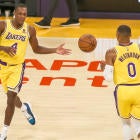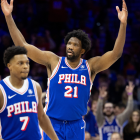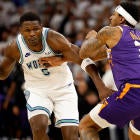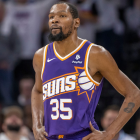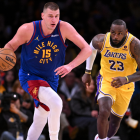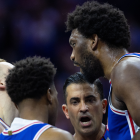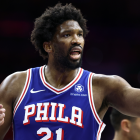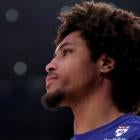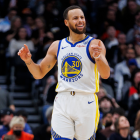
It's opening night. The Los Angeles Lakers are trotting out a new superteam against one of their biggest rivals, who also happens to be missing one of its best players. The result is disastrous. Practically everybody aside from LeBron James and Anthony Davis struggles. Bold proclamations are made about the team's viability. For the next several days, the sky might as well be falling.
Would you believe that I'm not describing the 121-114 defeat the Golden State Warriors handed Russell Westbrook and his new-look Lakers on Tuesday? No, I'm describing a very similar game that took place nearly two years earlier. On Oct. 22, 2019, James and Davis played their first game as teammates. Kawhi Leonard defeated them without Paul George by his side. Lakers not named James, Davis or Danny Green combined to score only 29 total points. Go check out some of the headlines that followed that debacle if you need a sense of how grim things looked in the immediate aftermath.
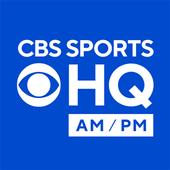
CBS Sports HQ Newsletter
Your Ultimate Guide to Every Day in Sports
We bring sports news that matters to your inbox, to help you stay informed and get a winning edge.
Thanks for signing up!
Keep an eye on your inbox.
Sorry!
There was an error processing your subscription.
We all remember what happened in the months that followed. The Lakers went 24-2 in their next 26 games. James became an MVP candidate while Davis made his case for Defensive Player of the Year. Those same Clippers wilted in the bubble. The Lakers won the championship.
History is by no means guaranteed to repeat itself, and the problems facing the 2021-22 Lakers cut significantly deeper. The 2019-20 version, frankly, made sense. James was the NBA's best playmaker. Davis was the NBA's best play-finisher. Every player on the roster existed solely to support them, largely by making 3s and play defense. The current model is significantly more complicated for a variety of reasons that extend well beyond Westbrook. Every player who took the floor on Tuesday aside from James, Davis and Westbrook are making the minimum this season. The defenders that made the 2019-20 team so special are largely gone, and many of those the Lakers expect to replace them are shaky enough shooters to be questionable fits with James and Davis. Figuring out the mix alongside these three stars is going to take some time.
But it's worth remembering that it took time for that previous Lakers roster as well, even if it wasn't very much of it. Remember, Davis, as he did against the Warriors, hardly played any center in his Lakers debut. Alex Caruso got DNP'd, but Jared Dudley, Troy Daniels and Quinn Cook played 46 combined minutes. It didn't take Frank Vogel long to adjust to these mistakes. They played a tight first half against the Utah Jazz in their second game three nights later, so Vogel dusted off Caruso, moved Davis to center and watched his team rock the Jazz by 13 points in the third quarter. They were off to the races from there. Davis didn't play all of his minutes at center and Caruso wasn't suddenly a starter, but Vogel figured out what worked and unleashed it when it mattered. Caruso started Game 6 of the NBA Finals -- the championship-clincher -- and did so alongside Davis at center, where he spent most of the 2020 postseason.
The adjustments aren't going to be as simple this time around, especially with Trevor Ariza, Talen Horton-Tucker, Wayne Ellington and Kendrick Nunn all nursing injuries. The rotation is going to change frequently as they trickle back into the lineup, and it's going to take Vogel months to crack the code of this roster as a whole. But that doesn't excuse some of the utterly bizarre lineup choices that Vogel made against the Warriors. So let's go through some of the short-term adjustments that the Lakers can make to help right the ship until the cavalry returns.
1. Put DeAndre Jordan on ice
Let's take a look at what Westbrook sees on one of the very first possessions of the game for the Lakers.
Westbrook has Stephen Curry in front of him … and Kevon Looney at the rim, largely ambivalent toward DeAndre Jordan … and Draymond Green at the nail perfectly content to allow Davis, a career 31.2 percent 3-point shooter, to try his luck behind the arc. That's three of the five defenders on the floor locked in on keeping him away from the rim, and the numbers were often less favorable. Some of this is avoidable. Davis has a relatively poor jump-shooting track record (2020 postseason aside). Teams are going to let him shoot no matter what. Playing him alongside Jordan shrinks the paint significantly for Westbrook and even more for James, who also has to contend with Westbrook's poor shooting.
If that's the sacrifice you're making by playing Jordan, what are the theoretical benefits? The notion that he's going to be some lob-catching menace from the dunker's spot or in the pick-and-roll is, at best, redundant. Davis is the best lob-catcher in NBA history. In theory, there's plenty of value in playing Westbrook with a former rebounding champion for the sake of jump-starting transition opportunities … except Jordan's effort and athleticism has slipped significantly since then. He pulled in two rebounds in 13 minutes, and unlike the bigs Westbrook played with in Oklahoma City, he isn't as eager to clear space for Westbrook to grab boards himself. He wasn't credited with a single box-out on opening night by NBA.com's tracking data. If the argument is that Jordan somehow improves the defense by offering double-barreled rim protection alongside Davis, well, I'd direct you to Golden State's very first offensive possession to quickly dispel that notion.
It's unclear what starting lineup Vogel would have used with a healthy roster. Maybe Jordan was meant to be an emergency player and this just turned into an emergency much faster than anyone expected. But his presence isn't doing anyone any favors except perhaps Davis, who has in the past made it clear that he prefers playing power forward. That was fine on the 2019-20 roster. It isn't now. Reports indicated that Davis was willing to play significantly more center this season to accommodate Westbrook. He's going to have to live up to that if the Lakers are going to survive. Playing center is no longer optional. Maybe Dwight Howard needs to play more bench minutes and maybe the two of them need to play together a bit in non-Westbrook minutes, but the preseason suggested Jordan no longer carries any real utility as an NBA player, and opening night supported that notion. There's a reason that the Nets gave up so much draft capital just to dump him. He's making Westbrook's life harder. Speaking of which …
2. If you must play Rondo, play him without Westbrook
Rajon Rondo has substantially more political capital within the Lakers organization than Jordan. He's won a championship in purple and gold. James and Davis swear by him. Vogel frequently cites his swag as an invisible contribution. That's all well and good, but I'm pretty sure swag carries less value than spacing in the 2021 NBA. Rondo and Westbrook have practically no synergy with one another as players. This possession is a nice example of that. It opens with Rondo trying to make a play … while Westbrook watches. It concludes with Westbrook trying to make a shot … while Rondo watches. Their defenders are constantly watching the one who has the ball, because the one who doesn't poses practically no threat.
The Lakers played the Rondo-Westbrook pairing together for seven minutes. They lost those minutes by 15 points. This isn't rocket science. Rondo and Westbrook are point guards. Playing them together makes one of them a shooting guard that can't shoot. Some of the lineups that Vogel used took that concept to the extreme. At one point, Rondo and Westbrook shared the floor with Howard, a true center, Davis, whose shooting deficiencies we've covered, and Kent Bazemore, a roughly league-average marksman for his career. How this unit was assembled, I cannot tell you, but it should never be used again.
There's an argument suggesting that Rondo shouldn't be, either. Remember, prior to his performance in the bubble, he had been among the worst regular-season players in basketball for two full seasons with the Lakers. The entire argument for having him on the team rested on his mythical playoff form, but he was hardly even part of the rotation for the Clippers last postseason. He's 35. For all of his veteran guile, he might simply no longer be a viable NBA player. Even if he is one, there are better uses of his talents than playing him alongside Westbrook.
If Rondo is going to play, pair him with LeBron James. Any guard who shares the floor with Westbrook needs to be able to shoot. Malik Monk is at the top of that list. Avery Bradley will be helpful as well for a variety of reasons. Not only was his defense sorely needed in the opener, but he's a living example of how a player can and should adjust to LeBron over the course of a season. Look at Bradley's shot distribution across the 2019-20 season by month:
| Month | Mid-range attempts per game | 3-Point attempts per game |
|---|---|---|
November | 3.3 | 2.5 |
December | 1.7 | 2.6 |
January | 1.9 | 2.4 |
February | 1.9 | 5.1 |
March | 1.6 | 6.4 |
Westbrook's adjustment is going to be different from Bradley's, but there's value in having him on the floor as an example of sacrifice within this offense, especially one that fits so well alongside him. Undrafted rookie Austin Reaves might as well, considering his shooting acumen and high basketball IQ. The exact players Westbrook should play with will present themselves over the course of the season, but for now, at a bare minimum, we can comfortably say that Rondo isn't one of them. But there's another player he should be separated from as well, at least to an extent.
3. Fully stagger Westbrook and LeBron
Virtually every team in the NBA with multiple high-usage perimeter players staggers their minutes fully. While the two will generally play quite a few minutes together, the team also ensures that they have at least one of them on the floor at all times. That wasn't the case for the Lakers on Tuesday. They played four minutes with neither Westbrook nor James in the game. Meanwhile, they played seven minutes with James and Westbrook together, but no Anthony Davis.
Doc Rivers authored the argument in favor of this approach last season when he refused to fully stagger Ben Simmons and Joel Embiid. The idea was to maximize their regular-season minutes together even if it cost the 76ers a few wins so as to improve their chemistry when the playoffs arrived. As poorly as that worked out for them, the idea that Vogel wants to embrace this pairing so it works in the postseason isn't necessarily crazy in the long run. It's just a bit unfair to both players early in the season.
James and Westbrook are both used to running entire offenses. Getting either to accept a co-pilot role is going to take time, and both of their lives would be easier knowing that they'd have 10-12 minutes per night as the offense's lone ball-handler. James, having played with Rondo and other similar players in the past, is likely a bit more able to accommodate overflow in that department. But if the Lakers are going to get Westbrook -- who shot 4 of 13 for eight points Tuesday night -- into a groove, they should probably start by giving him minutes in which he can play something closer to the type of basketball he's used to. We're talking baby steps here.
And, of course, there are tangible basketball benefits to this approach as well. The Lakers have seen their offense struggle mightily in all three seasons of the LeBron era when he's gone to the bench. Part of the value of adding Westbrook is that his ball-handling could in theory change that. James has typically thrived as the lone star with bench units, so splitting the two of them up and allowing Westbrook to run pick-and-roll with Davis for half of a quarter makes quite a bit of sense. It's certainly an easier fit than forcing Westbrook and James to play dueling banjos in those minutes.
All told, these changes would streamline the Lakers rotation into something a bit easier to grasp. The star trio should open games with two shooters on the floor to ensure that they have room to operate near the basket. Westbrook and Davis should then share the floor with reserves, and if Davis needs extra rest, sneaking in some Howard minutes here makes some sense. The Lakers would follow that up, as they have for three years, with James leading a reserve-heavy lineup. Then the final minutes of each half would depend on what has worked thus far.
In the end, some version of this approach is probably where Vogel is going to settle. It probably won't happen as quickly as it did during the 2019-20 season, but if the goal is maximizing the talent at hand, this is probably the simplest way to do it.













